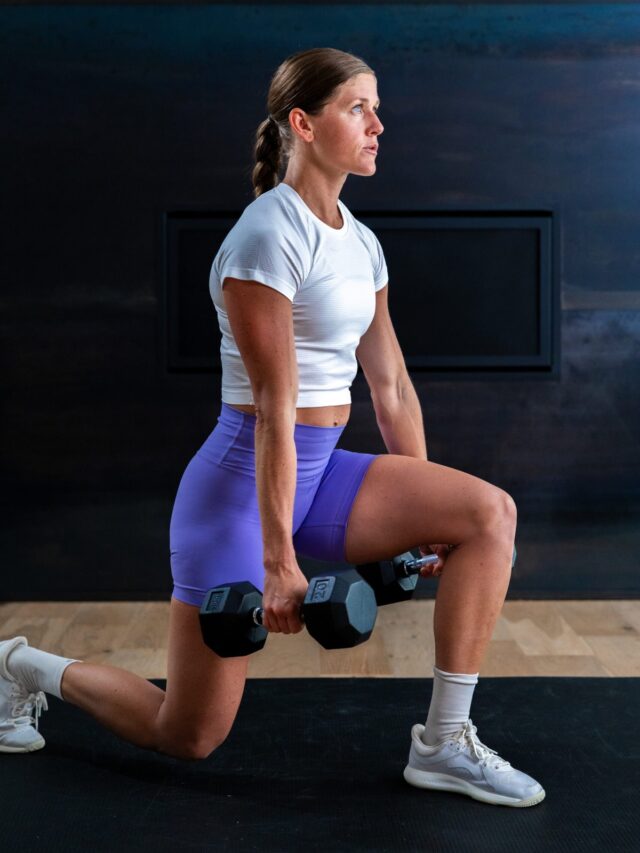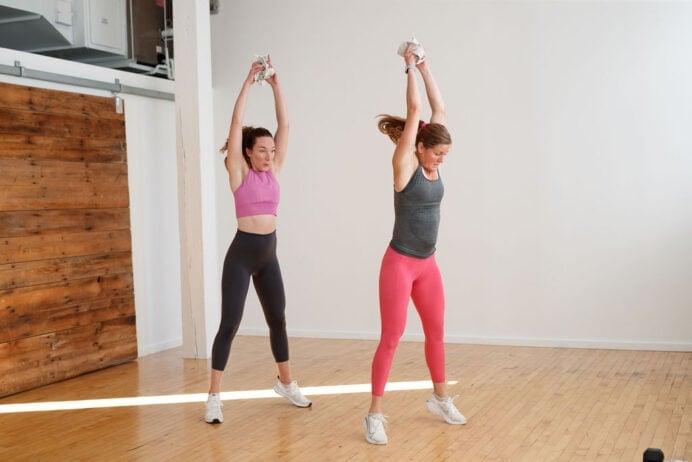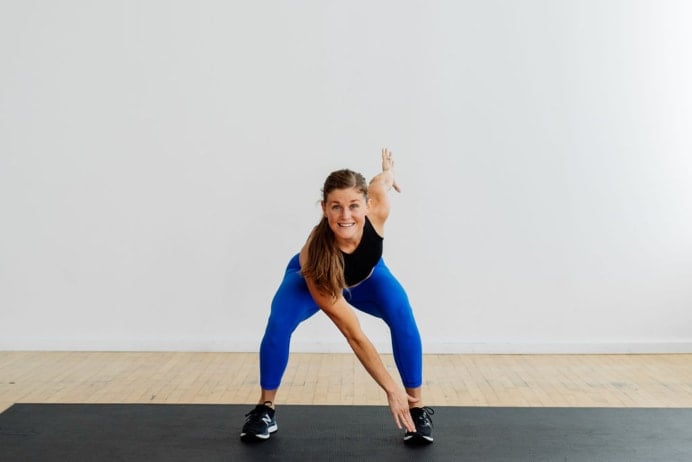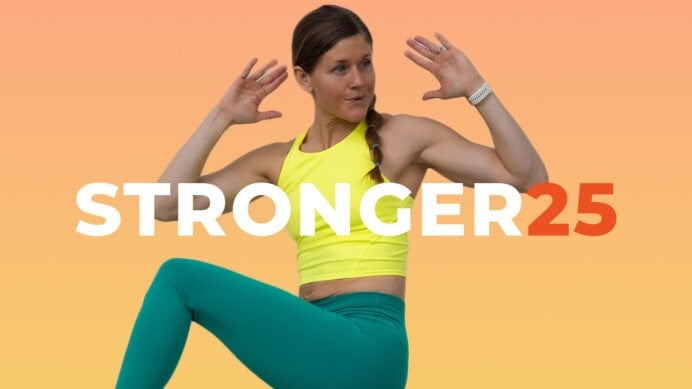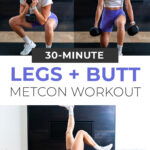

30-Minute Dumbbell Lunges Workout (MetCon, Day 8)
Build total lower body strength with this dumbbell lunges workout. This lower body workouts targets the quads, hamstrings, glutes, calves and thighs using dumbbells. The ultimate challenge: complete 100 lunges by the end of this strength and conditioning workout.
This is DAY EIGHT of our MetCon 100 Program.

LET’S GET STARTED
Download Your FREE Workout Plan Here
Challenge your lower body strength and endurance with this dumbbell lunges workout.
Day eight of our 2-Week MetCon 100 Program challenges you to complete 100 dumbbell lunges.
The lunge is a great lower body exercise that targets the glutes, hips, hamstrings, quads, calf muscles and core. Lunges are a unilateral exercise that challenge your balance and coordination.
You’ll complete ten sets of ten lunges throughout the workout for a total of 100 lunges. Plus, there are several lunge variations included throughout the workout.

Dumbbell Lunges FAQs
The dumbbell lunge targets multiple muscle groups, including the quadriceps, glutes, and hamstrings. Lunges also train the knees and hips as those joints flex and extend during the movement. Dumbbell lunges are a great unilateral exercise targeting muscle imbalances in the legs and glutes.
Adding dumbbells or weights provides an extra challenge for the quads and glutes. That said, bodyweight lunges are an effective exercise as well. Lunges are a functional lower body exercise that build strength and challenge your mobility, balance and coordination. If you are working on building knee strength, an isometric lunge hold is a great alternative to dumbbell lunges.
Dumbbell lunges are a weighted variation of forward or reverse lunges. To perform a dumbbell lunge, you’ll hold a set of dumbbells in each hand as you step back, lowering one knee towards the ground as you aim for 90-degree bends in both knees. Drive through the front heel to stand tall and repeat. Maintain distance between your feet throughout the exercise (think of standing on train tracks rather than a tightrope).
Squats and lunges are both foundational leg exercises that target several lower body muscle groups. It’s important to train both of these movements to practice good form and ensure you’re able to move pain-free in your daily life. I recommend including a variety of lower body exercises in your workout routine to challenge your strength and muscular endurance.
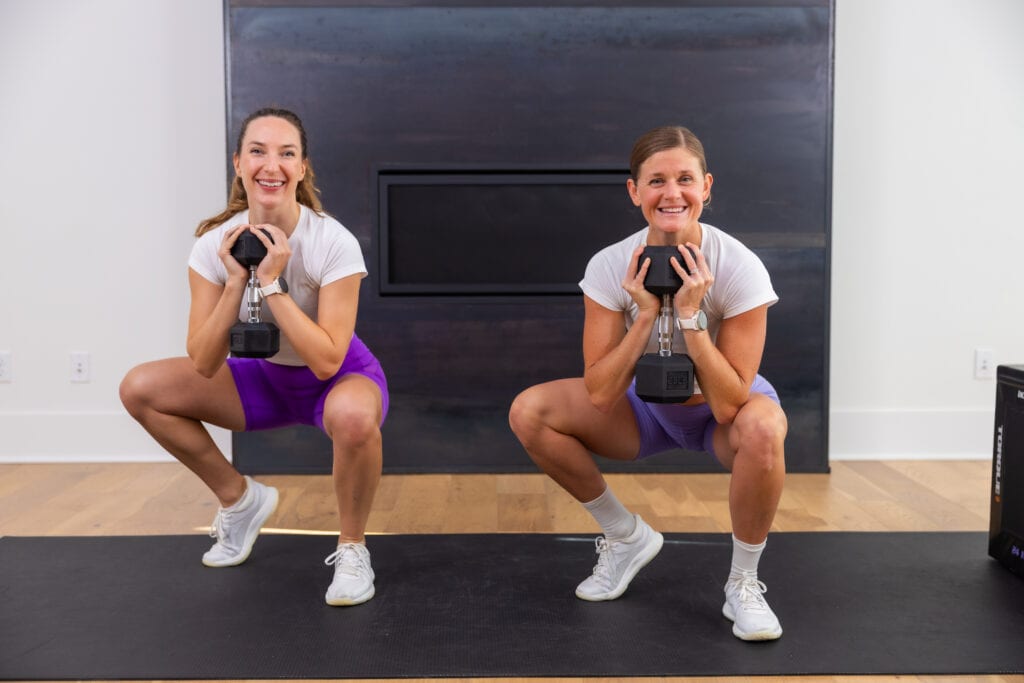
30-Minute Dumbbell Lunges Workout (MetCon, Day 8)
Build lower body strength at home using just a set of dumbbells in this dumbbell lunge workout.
This metabolic conditioning workout challenges you to complete 100 lunges. This is a complete lower body workout targeting the quads, hamstrings, glutes, calves and thighs.
I suggest doing this lunge workout once a week as part of a well-rounded workout routine.
Workout Equipment:
Medium to Heavy Set of Dumbbells. I recommend between 5-30 lbs depending on your fitness level. We used 15, 20 and 25 lb dumbbells in today’s workout. Option to drop weights at any time and perform bodyweight lunges.
Option to add a plyo box (or sub a bench/chair).
Shop strongfeel Women’s Training Shoe

Workout Instructions:
Follow along with the guided Lunge Workout on YouTube, led by certified personal trainer and fitness instructor, Lindsey Bomgren.
Your Workout Looks Like This:
- 9 Dumbbell Leg Exercises
- Timed Intervals (30 seconds work, 15 seconds rest. Complete as many reps as you can in the timed interval.)
- Strict Sets (repeat each leg exercise x 2 sets, back-to-back)
- Perform 10 Lunges After Each Exercise For a Total of 100 Lunges
Workout Outline
- Dumbbell Reverse Lunges
- L-Stance Goblet Squat
- Staggered Deadlift, Clean and Front Squat
- Lateral Squat
- Rotational Lunge
- Rear Foot Elevated Split Squat
- Rear Foot Elevated Single Leg Deadlift
- Lateral Foot Elevated Single Leg Squat
- Reverse Hyperextensions
- Elevated Single Leg Glute Bridge
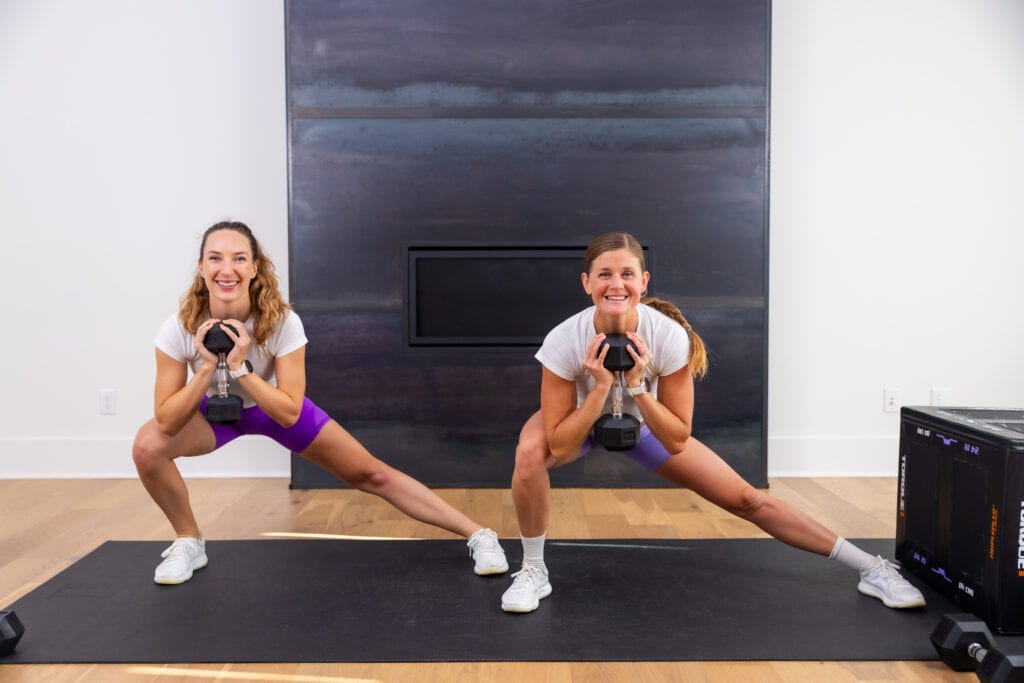
Prefer to Watch On YouTube?
10 Lower Body Strength Exercises
Dumbbell Reverse Lunges
Targets: Legs, glutes, quads, hamstrings and core. Lunges also target the small stabilizing muscles in your hips and thighs.
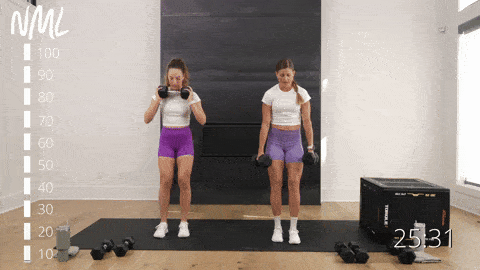
How To Do A Reverse Lunge With Dumbbells
- Start standing in a neutral position, feet hip-width apart, holding a dumbbell in each hand, palms facing in towards each other (hammer curl grip). Option to hold one dumbbell horizontally at your chest.
- Step your left foot back into a reverse lunge. Lowering your left knee towards the mat, aiming for 90-degree angles in both knees.
- Hold for a moment, then drive through your front, right heel to return to standing.
- Then alternate the movement, this time stepping your right foot back into a reverse lunge.
L-Stance Goblet Squat
Targets: Legs, glutes, quads, hamstrings, hip abductors and core.
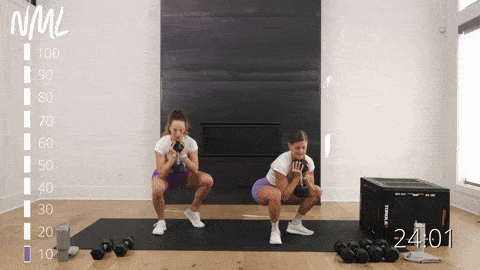
How To Do A L-Stance Goblet Squat
- Stand with your feet hip-width apart. Hold one dumbbell vertically at your chest in a goblet hold.
- Find a L-stance by rotating your torso slightly to the right, at about a 45-degree angle. Create the “L” shape with your feet by pointing your left toes forward and turning the right foot out, right toes facing the right wall. Pop the right heel off the ground.
- Inhale as you bend your knees and sit your hips back (as if sitting down in a chair). Aim for 90-degree bends at each knee, focusing on pushing your knees out (not letting them cave in). Keep your torso upright.
- Exhale as you press through your front left heel to stand tall, driving your hips forward to return to standing. Maintain the L-stance the entire time.
Staggered Deadlift, Clean and Front Squat
Targets: Glutes, hamstrings, hips, quads, calves, trapezius, deltoids, lower back, abs and core.
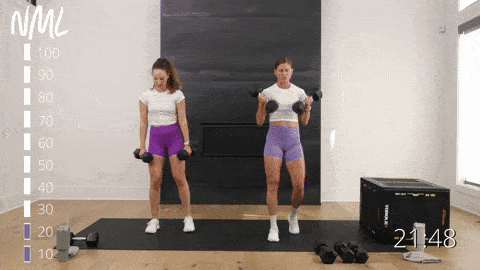
How To Do A Staggered Deadlift, Clean and Front Squat
- Stand with feet hip-width apart, knees slightly bent. Hold a set of dumbbells in front of your body, palms facing in.
- Stagger your feet, so your left leg is slightly in front of your right foot. Kickstand your back right foot, right heel floating off the ground. Keep 80% of your weight in your front foot, 20% in your back right toe.
- Maintain a staggered stance as you hinge at the hips. Pushing your hips back towards the wall behind you as you glide the dumbbells down the front of your legs; core tight.
- Then, drive through your heels to stand tall, bringing your right foot parallel to your left foot.
- As you stand, bring the dumbbells up towards your chest (this is the “clean” portion of the clean squat). Catch the dumbbells in a front racked position at shoulder height.
- Lower down into a squat position, lowering your hips down parallel to your knees. Both knees bent at 90-degree angles. Drive your knees out toward your outer three toes.
- Drive through your heels to stand tall again, finding a staggered stance again by stepping your right foot back.
- Continue this pattern, alternating one staggered deadlift with a dumbbell clean and front squat.
Modification: Omit the clean, performing staggered deadlifts and squats, keeping the weights at your sides.
Lateral Squat
Targets: Gluteus medius (outer glute that controls hip movement and side-to-side movements), quads, inner thighs (or hip adductors), hamstrings and calves.

How To Do A Lateral Squat
- Start with your feet wider than your hips (think a wide squat stance), with your knees and toes pointing forward. Or toes just slightly turned out away from your body.
- Hold one dumbbell at your chest like you would during a goblet squat (vertically so dumbbell is touching your collarbone and sternum), elbows tucked in.
- Shift your weight into your right heel as you push your hips back, bending your right knee while leaving your left leg straight. Think of performing a single leg squat with your right leg while your left leg remains straight.
- Then, drive through your right foot to reverse the movement, pushing you back up to center.
- Then shift your weight into your left heel as you push your hips back, bending your left knee while leaving your right leg straight.
- Repeat for the timed interval, alternating the leg that performs a lateral squat.
Rotational Lunge
Targets: Legs, glutes, quads, hamstrings, hip adductors, knee and ankle joints, lower back and core.

How To Do A Rotational Lunge
- Start standing in a neutral position, feet hip-width apart. Hold one dumbbell in your left hand, palm facing in towards your body and front racked at your left shoulder.
- Step your left foot back, rotating your left toes and both hips 90 degrees to face the left wall. Right toes stay facing the front of the room.
- Bend your left knee and sit back towards your left hip, keeping your right leg straight. Think about performing a single leg squat on the left side. Right toes pop off the mat (toes up towards the ceiling).
- Then, drive off your bent left leg to reverse the movement, standing tall and facing the front of the room.
Rear Foot Elevated Split Squat (Bulgarian Lunges)
Targets: Legs, glutes, quads, hamstrings, hips and core.

How To Do A Rear Foot Elevated Split Squat (Bulgarian Lunges)
- Kneel in front of your bench or chair, then place your left foot behind you on a chair or bench, shoelaces down. Hold a set of dumbbells at your sides, palms facing in.
- Step your right foot forward (it will vary for everyone, but a little over a foot in front of your bench). Your front thigh will be parallel to the floor. This is the bottom of your movement.
- Drive through your front right heel, squeezing your right glute to return to standing. Feel your front glute engage to power the movement.
- With control, bend your knee to lower down back to the starting position (back left knee should lower down close to the ground), to make your front thigh parallel with the ground. Shoulders remain stacked over hips throughout the movement.
Modification: Perform a standard reverse lunge or split squat, keeping your back foot on the ground rather than elevating it on a chair.
Rear Foot Elevated Single Leg Deadlift
Targets: Hamstrings, core and glutes.

How To Do A Rear Foot Elevated Single Leg Deadlift
- Start standing in front of a bench or chair, holding a set of dumbbells in front of your body, palms facing in. Place your left foot behind you on the bench, shoelaces down.
- Keeping hips square, press your glutes back towards the wall behind you, hinging at the hips and gliding the dumbbells down your front leg until you feel a stretch along the back of your right leg. Range of motion will be different for everyone.
- Exhale as you press through your front heel and stand tall, returning to starting position.
Modification: Perform a staggered deadlift from the ground, keeping 80% of your weight in your front heel and 20% in your back toe.
Lateral Foot Elevated Single Leg Squat
Targets: Legs, glutes, quads, hips, hamstrings, outer glutes, inner thighs and core.
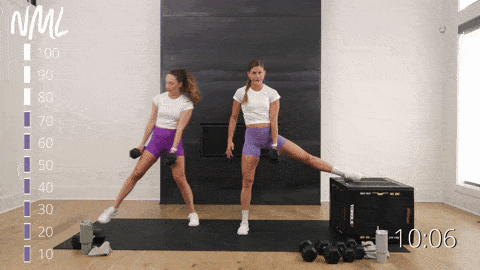
How To Do A Lateral Foot Elevated Single Leg Squat
- Plant your left foot firmly on the ground and place the edge of your right foot on a box or bench. Your left leg should be far enough away from the box that the right leg remains straight. Your left and right legs will make about a 45-degree angle. Hold one dumbbell in your right hand, palm facing the left leg.
- Shift your weight into your left heel as you push your hips back, bending your left knee while leaving your right leg straight. You’re performing a single leg squat with your left leg while your right leg remains straight. Glide the dumbbell down, aiming to get as close to the ground as possible. Range of motion will vary depending on your hip mobility.
- Then, drive through your left foot to stand tall.
Modification: Option to perform lateral lunges, stepping the left leg out to the side as you push your hips back, bending the left knee while leaving your right leg straight. Drive off your left foot to reverse the movement, pushing back to center and repeat.
Reverse Hyperextensions
Targets: The hip extensors (gluteus maximus and hamstrings), erector spinae and lower back.

How To Do Reverse Hyperextensions
- Start by lying belly down on your box or bench. Grip the outer corners of the box as you drive your chest firmly into the box. Your hips should rest at the very edge of the box so your legs fall off the side (creating a 90-degree bend at the hips), slight bend in the knees.
- Brace your core as flex the muscles in your hamstrings, glutes and lower back to raise your legs from below your hip line to above the hips.
- Squeeze your glutes as you hold at the top for a moment, then lower your legs back down with control.
Modification: If lying on your belly isn’t comfortable, perform butterfly or frog glute bridges.
Elevated Single Leg Glute Bridge
Targets: Glutes, hamstrings, hips, low back and core.

How To Do An Elevated Single Leg Glute Bridge
- Lie on your back with your knees bent, about a foot from your bench (couch or chair). Make sure your bench is stable and won’t slide out from underneath you.
- Place your right heel on the edge of your bench. Right leg bent at 90 degrees. And extend your left leg straight overhead (ankle stacked over hip).
- Then, drive through your right heel, squeezing your right glute to raise your hips.
- With control, lower your hips, aiming to hover a couple inches off the ground before.
Modification: Perform a single leg glute bridge from the ground (not elevated). Or perform a standard glute bridge with both feet on the ground.

MetCon 100: FREE Metabolic Conditioning Program
A 2-week metabolic conditioning program designed to show you that you’re stronger than you think.
If you liked this lower body workout at home, download the FREE, 2-Week Workout Plan.
Up Next:
See AllPin This Workout: Dumbbell Lunges Workout (MetCon, Day 8)

More Lower Body Workouts At Home:
This post includes affiliate links. I do earn a commission for products purchased using these links (at no additional cost to you). Thank you for supporting Nourish Move Love, making the content you see on this blog possible.










